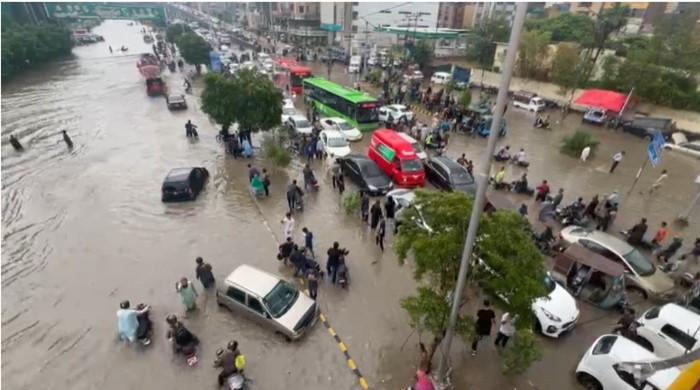“I am scared,” he sent me a 20 -year -old university message, he sent me a message. “The bus on which he was traveling was broken on the road between Nazimabad and Teen Hatti. We had to go down and find our way home. We had no choice but to walk in the water almost to the knees.”
“We were afraid, since in some places the water was up to the waist for men, and we are barely 5 feet. As women, we cannot ask anyone for help. I don’t know how we get home.”
Saima said they did not dare to ask anyone for help and for obvious reasons. Many families passed in high vehicles, offering to give them an elevator, but chose to cross water and face other threats instead of seeking help.
Fortunately, Saima and her friend Sughra came home despite the difficulties, even though she took a long time.
Thousands of women in all Karachi faced problems similar to the different parts of the city received around 145 millimeters of rain from 8 in the morning of August 19.
People stuck in offices, schools, markets and other places due to the heavy rain that wreaked havoc, making the displacements extremely difficult.
Like thousands of other drivers, drivers and cyclists faced problems, since some left their vehicles that broke or stuck in the water.
Shama, a teacher, had to leave her car almost in the middle of the road. “I was forced to turn off Share Faisal. People were hitting my window to warn me. I knew they were trying to help, but I was afraid of” attention. “Some people tried to push my car near the sidewalk, but they only managed to change it a bit to the side.”
“Although I was afraid to get out of the car, an older gentleman came and told me to come out, saying that it was dangerous to continue sitting in a submerged car. He said: ‘Grab my arm and I will take it out.’
Many young girls, probably school or university students, made their way through flood water that was held by the shoulder or holding hands, walking in training. They had formulated a plan to deal with the situation, which showed that they could address it.
However, sometimes, as Shama added, he knew that the older knight was trying to help her, but said that, since a very young age, girls and boys are generally segregated according to religious, cultural and social norms. However, Shama realized that at extraordinary times such as floods, natural disasters or accidents, we should make women and girls allow the rescue personnel (mostly men) to save them.
Other problems faced by women while traveling under the heavy rain were fear for their personal safety, as well as those of their loved ones. Fatima, a 25 -year -old married woman, was traveling with her husband in her Japanese bass car. Soon, this car could not address flood water on roads.
“This car is not made for Karachi roads; it comes from a city that is well planned and does not have to deal with one foot or more water,” said Fatima. “However, I was more afraid of my husband’s safety when our car broke into a street. I was afraid that street criminals take advantage of the situation and our vulnerability. I was too scared to get my phone to talk to the family.”
Based on the past, Fatima probably had good reasons to be afraid, since the media often report on active street criminals in severe traffic traffic jams.
He added that he did not dare to walk like many others because he has lived a protected life and felt vulnerable outside the vehicle.
“I realized that women like me are so protected that we don’t know how to” survive “on the way in normal times. I am one of the many women who say they don’t know how to cross the road. I am sure I could not navigate on a flooded path, with my” telephone and design bag. “It would be an objective.”
The most important thing is to train women about what to do in such situations. In addition, it is vital to educate society about the important role that rescue personnel play during extraordinary situations such as floods and strong rains. They are trained to work in dangerous circumstances, but they cannot do their job if people trying to save are not ready to be rescued due to social or cultural restrictions. The government needs to carry out awareness campaigns so that people know that rescue personnel are trained to save their lives.
On the other hand, rescue teams must be trained on how to do their job while understanding cultural and social sensibilities. They must receive training on harassment and sexual harassment in the workplace, and that there are serious consequences in the case of violating the trust of any person.




